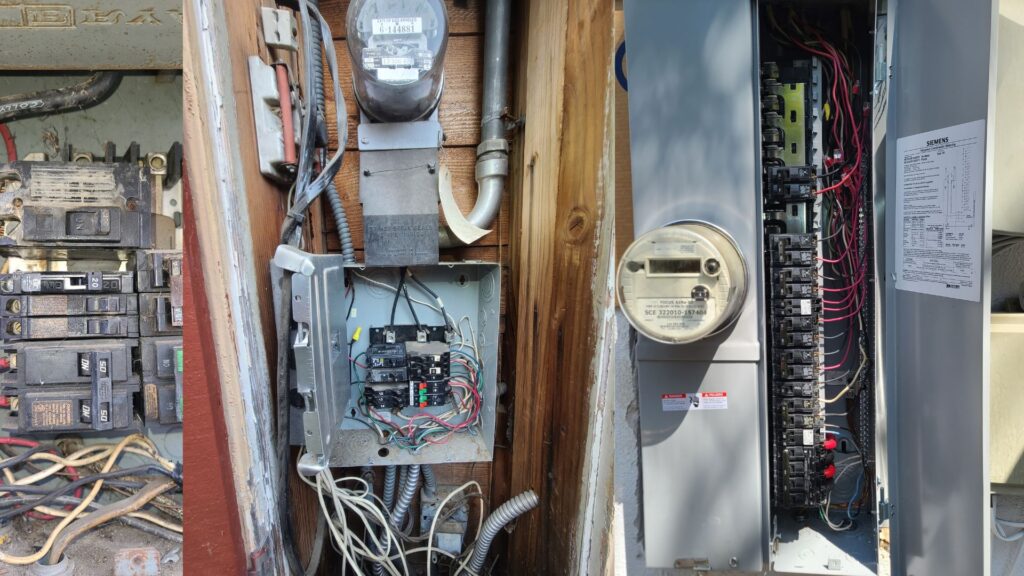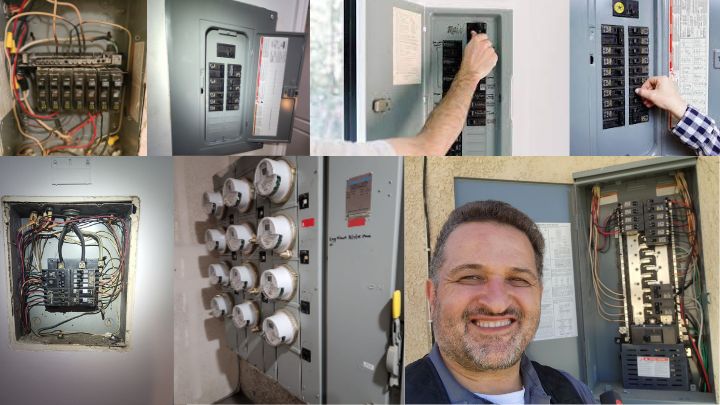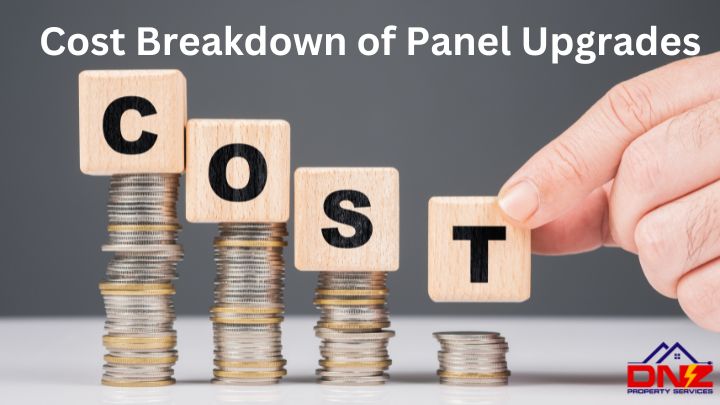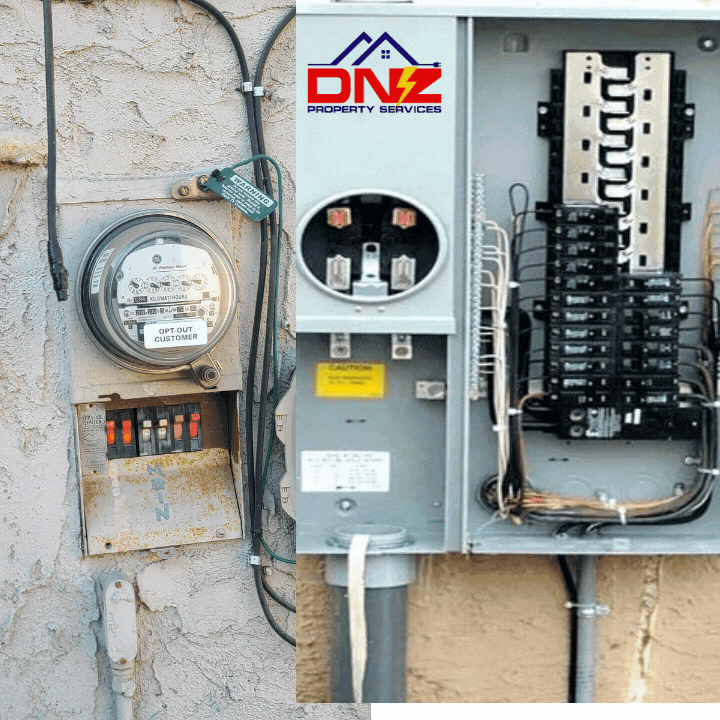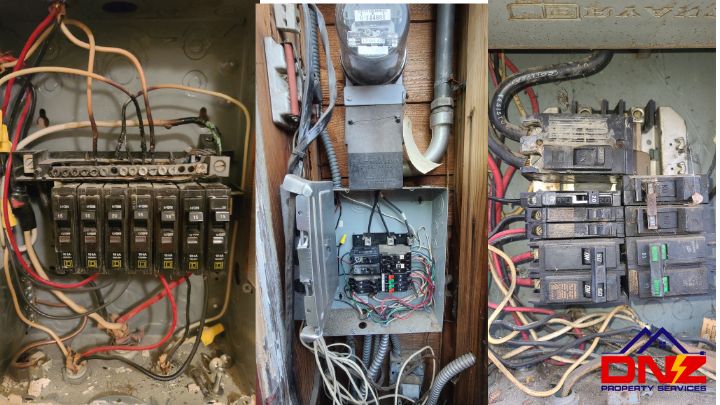How Much Does It Cost for Panel Upgrades in 2023?
How Much Does It Cost for Panel Upgrades
Are you struggling with electrical issues in your home and unsure whether a panel upgrade is the right solution? In today’s world of increasing electricity demands and evolving technology, understanding the costs and benefits of panel upgrades is crucial.
In this blog post, we’ll help you determine the right electrical panel upgrade for your home, explore the costs involved, and provide tips on saving money during the process. Let’s make your home safer, more efficient, and ready for the future.
Key Takeaways
- Determining the right electrical panel upgrade for a home requires professional assistance and an evaluation of its electrical needs.
- Costs vary depending on labor, materials, permits & amperage. Additional expenses should be considered when planning upgrades.
- Hiring a professional electrician is recommended to ensure safety and efficiency while taking advantage of savings opportunities such as tax credits or rebates.
Determining the Right Electrical Panel Upgrade for Your Home
Your home’s electrical panel is the vital link between public utility lines and your house. It is responsible for distributing power throughout the house. Upgrading your home’s electrical panel ensures that your home can adequately handle modern appliances and electronics, improving safety and power distribution.
How then, do you decide on the right panel upgrade for your home? We’ll be exploring your home’s electrical needs and discussing the different types of electrical panels available.
Evaluating Your Home’s Electrical Needs
When assessing your home’s electrical needs, consider the size of your home, the number and types of electrical appliances, and any future additions or renovations. A larger home with multiple large appliances, such as HVAC systems, heat pumps, and central air conditioners, will require a higher amperage electrical panel to accommodate the increased electrical load. Don’t forget to factor in the growth of electronic devices and electricity usage in today’s modern households.
The National Electric Code (NEC) requires that conductors be sized to accommodate an ampacity of at least 125% of the noncontinuous electrical load for which they are rated, known as the 125 rule. This ensures that your electrical panel can safely handle your home’s electrical demands without overloading or causing potential hazards.
Consult with a professional electrician to accurately calculate your home’s electrical load, taking into account any planned expansions or upgrades.
Types of Electrical Panels
There are several types of electrical panels to choose from, including:
- Circuit breaker panel: the most common type, featuring a circuit breaker switch that regulates the primary power source to a residence.
- Fuse box: typically found in older homes, uses fuses instead of circuit breakers to regulate the power supply, but they are less dependable and present a higher risk of overloading and fire.
- Subpanels: used to expand the capacity of an existing electrical system.
- Main lug panels: used as a secondary panel to distribute power to specific areas or appliances.
Subpanels and main lug panels help to decrease and better distribute the electrical load, improving the efficiency and safety of your home’s electrical system. Subpanels are additional electrical panels added to a home, while main lug panels are subpanels of the main breaker.
When selecting the right type of panel for your home, consider factors such as the age of your home, the type of appliances, and your future electrical needs. Consult with a professional electrician to determine the best option for your specific situation.
Cost Breakdown of Panel Upgrades
It’s crucial for budgeting and planning purposes to grasp the cost breakdown for panel upgrades. Factors such as labor, materials, and permits contribute to the total cost, and these can fluctuate based on the size and complexity of the upgrade.
We shall explore these components more thoroughly to guide you in making an informed decision.
Labor Costs
Labor costs for panel upgrades typically account for a significant portion of the total electrical panel costs. The cost of labor depends on the electrician’s hourly rate and the complexity of the job, which can include relocating an indoor panel outdoors, rewiring inside walls, or repairing drywall after installation. The cost of labor to upgrade an electrical panel can vary, but the average has been estimated at $3,500. This is just a general guideline; prices can fluctuate depending on many factors. However, this can vary widely depending on your location and the specific details of your project.
Working with a licensed electrician is advised to guarantee the safe and efficient completion of your panel upgrade. Although hiring a professional may seem more expensive initially, it can save you money in the long run by avoiding costly mistakes and ensuring the job is done correctly the first time. Additionally, a licensed electrician will be familiar with local building codes and permit requirements, helping you avoid any potential fines or violations.
To get the best value for your money, it’s a good idea to collect quotes from several highly rated electricians in your area. This provides you with a range of estimates and allows you to compare costs, services, and qualifications to find the best fit for your panel upgrade needs. Keep in mind that the lowest quote may not always be the best choice; consider the electrician’s experience, reputation, and customer reviews when making your decision.
Material Costs
Material costs for panel upgrades include the panel itself, wiring, and any additional components needed for the upgrade. The cost of the panel varies depending on the amperage. Contact Us for detailed custum pricing.
Additional components that may be required for the upgrade include:
Worn-out wiring
Damaged circuits
Old receptacles
Fittings
Connectors
Fasteners
These costs can add up, so it’s essential to budget for any potential extra expenses when planning your panel upgrade.
A professional electrician can help you determine the necessary materials for your specific project and provide you with an accurate estimate of the total material costs.
Permit Costs
Permit costs are another essential factor to consider when budgeting for a panel upgrade. Permits are typically required for panel upgrades, and the costs can vary depending on your location and the scope of the project. Generally, the cost of a building permit for electrical work, including panel upgrades, may range from $50 to $300.
Most electricians will obtain the permit for you, which can save you time and hassle. To determine the exact permit costs for your area, it’s best to contact your local building department. They can provide you with accurate information about permit requirements and fees specific to your location, ensuring you’re fully informed and prepared for your panel upgrade.
Comparing Panel Upgrade Costs by Amps
When contemplating a panel upgrade, comparing costs based on the amperage is a critical step in making an optimal decision for your home. Upgrading to a higher amperage panel provides coverage for potential growth and increased consumption, adding more value to your home and allowing for the addition of more breaker slots for future expansion.
These costs vary depending on the size of the home and the electrical load requirements.
It’s crucial to evaluate your home’s current and future electrical needs before deciding on an amperage upgrade. Consult with a professional electrician to help you determine the appropriate amperage for your home and provide you with an accurate estimate of the costs involved.
Additional Expenses to Consider
While planning your panel upgrade, remember to consider any additional expenses that may incur during the process. These can include:
- Relocation
- Rewiring
- Electric meter box replacement
- Subpanel installation
Relocation costs can vary depending on the distance of the move and the amount of additional wiring required. Rewiring costs typically range from $500 to $4,500, including labor and materials. Electric meter box replacement can cost between $100 and $500, and subpanel installation costs usually range from $400 to $1,750.
To ensure you have an accurate estimate of the total expenses for your panel upgrade, consult with a professional electrician. They can help you identify any potential additional costs and provide you with a comprehensive quote, allowing you to budget accordingly and avoid any unexpected surprises.
DIY vs. Professional Panel Upgrades
You may consider handling a panel upgrade as a DIY project to save money as a homeowner. While this could lead to labor cost savings between $200 and $1,000, it’s crucial to balance the benefits and downsides of a DIY panel upgrade against hiring a professional electrician.
Attempting a DIY panel upgrade comes with potential safety risks and a lack of technical proficiency. Working with electrical systems in a household setting is hazardous and can result in home fires due to electrical malfunctions and failures. It’s highly recommended to seek professional assistance and hire an electrician for panel upgrades.
Hiring a professional electrician ensures the panel upgrade is done safely and efficiently, avoiding costly mistakes and guaranteeing the job is done correctly the first time. Additionally, a licensed electrician will be familiar with local building codes and permit requirements, helping you avoid potential fines or violations.
Saving Money on Panel Upgrades
Several strategies can help you save money on panel upgrades. First, obtain multiple estimates from reputable electricians in your area. This allows you to compare costs, services, and qualifications, ensuring you get the best value for your money. Remember, the lowest quote may not always be the best choice; consider the electrician’s experience, reputation, and customer reviews when making your decision.
Another cost-saving tip is to consolidate electrical projects. Combining electrical work with larger home renovations can reduce labor costs by allowing the electrician from your local electrical company to complete multiple tasks in one visit.
Finally, take advantage of any tax credits and rebates available for qualified energy efficiency improvements, such as upgrading to energy-efficient appliances or installing heat pump water heaters.
By employing these cost-saving strategies, you can reduce the overall expense of your panel upgrade while still ensuring a safe and efficient outcome for your home’s electrical system.
Signs It’s Time to Upgrade Your Electrical Panel
Upgrading your electrical panel brings substantial benefits like improved power output, increased home value, and enhanced safety. So, how can you tell when an upgrade is due? There are several signs that suggest it may be time for electrical panel replacement or repair, including:
- Panels that are over 25 to 40 years old
- Panels with an amperage rating of 100 or lower
- Visible damage or rust
- Outdated technology
Other indications that it’s time to upgrade your panel include:
- Lights that frequently flicker, blink, or dim
- Circuits that feel hot to the touch
- Unusual sounds coming from outlets
- Frequent circuit breaker trips
If your panel is manufactured by Federal Pacific Electric Panel or Zinsco, it’s critical to consider an upgrade, as these electric panels have been associated with a higher risk of electrical fires.
If you notice any of these signs, consult with a professional electrician to evaluate your panel and determine whether an upgrade is necessary. Upgrading your panel before an issue arises can help prevent potential problems and ensure the safety and efficiency of your home’s electrical system.
Benefits and Drawbacks of Panel Upgrades
Panel upgrades come with many advantages, including:
- Increased power output
- Surge in home value
- Better protection against electrical fires
- Improved performance of lights and appliances
Upgrading an old electric panel to a new electrical panel is essential to minimize the potential for electrical fires at home. A current electrical system provides a more reliable and effective power supply.
However, panel upgrades do come with some drawbacks. The process can be disruptive to your home, as it necessitates a power shutdown and may take several hours to complete. Additionally, the costs involved in a panel upgrade can be significant, especially if additional expenses such as relocation, rewiring, and permits are required.
Despite these drawbacks, the benefits of a panel upgrade often outweigh the potential downsides, making it a worthwhile investment for many homeowners with an existing panel.
Summary
In conclusion, understanding the costs and benefits of a panel upgrade is essential in today’s world of increasing electricity demands and evolving technology. By evaluating your home’s electrical needs, comparing panel upgrade costs, and considering additional expenses, you can make an informed decision that best suits your home and budget. Don’t wait for electrical issues to escalate; invest in a panel upgrade now to ensure the safety, efficiency, and modernization of your home’s electrical system.
Frequently Asked Questions
Is it worth upgrading electrical panel?
It is definitely worth it to upgrade your electrical panel, as it will reduce the risk of an overload causing fires, and help your system work more efficiently. Furthermore, it can save you money in the long-term by increasing energy efficiency and preventing issues with lights and other appliances.
What is included in an electrical panel upgrade?
An electrical panel upgrade generally includes replacing the fuse box, adding a circuit breaker, and upgrading the amp service from the utility company. Those who notice flickering lights should consider replacement as it could potentially cause fires.
How much does it cost to upgrade to a 200amp panel?
The cost to upgrade to a 200-amp panel typically ranges from $750 to $1,800, depending on the complexity of the project.
Can I change my 100-amp panel to 200 amp?
It is not possible to upgrade from a 100-amp panel to a 200-amp panel by simply replacing the breaker panel. You will need new breakers, meter socket, service conductors, grounding electrodes and bonding conductors to upgrade to 200 amps.
Can I perform a panel upgrade as a DIY project?
Given the potential safety risks and lack of technical proficiency, it is highly recommended to seek professional assistance and hire an electrician for panel upgrades instead of attempting a DIY project.

